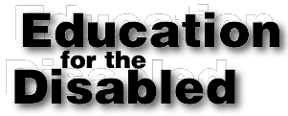

Mainstreaming: Mainstreaming is the practice of educating physically handicapped and learning disabled students in the same classroom environment with students who are not physically handicapped or learning disabled. An Individualized Education Program determines to what degree a physically handicapped or learning disabled student should be mainstreamed.
Least Restrictive Environment(LRE): LRE is "a program placement concept that means handicapped children should be educated in environments that are as 'normal' as possible. Within this framework, mainstreaming is considered the most normal, or least restrictive placement of handicapped children" (Anderson, 1980, p.9). The concept of 'least restrictive' does not eliminate special classes or services for handicapped students.
Individualized Education Program(IEP): The Individualized Education Program was created under P.L. 94-142, and designed to guarantee that each handicapped student's special needs are met within the least restrictive environment possible. An IEP is designed by a special education teacher, district representative, the parents, and child, and must be reviewed annually.